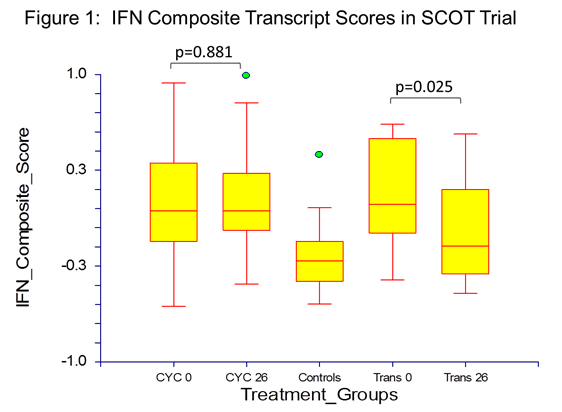Session Information
Date: Wednesday, November 11, 2015
Title: Systemic Sclerosis, Fibrosing Syndromes, and Raynaud's - Clinical Aspects and Therapeutics III
Session Type: ACR Concurrent Abstract Session
Session Time: 11:00AM-12:30PM
Background/Purpose: Previous clinical trials have suggested
that immunoablation followed by autologous hematopoietic cell transplantation
(HCT) can lead to clinical improvements in systemic sclerosis (SSc). However,
global gene expression studies for understanding the molecular basis of these
effects were not performed. We aimed at investigating changes in the
peripheral blood gene expression patterns ensuing after HCT in the randomized
SCOT trial.
Methods: Global transcript studies on Illumina
HT-12 arrays were performed in whole blood samples collected at pretreatment baseline
and 26 months post-randomization. Sixty-two SSc patients undergoing HCT or
receiving 12-month of IV cyclophosphamide (CYC) were investigated . The immune
reconstitution after immunoablation is generally completed at 26-months and patients
in CYC arm were off treatment for 14 months at that time point. Healthy controls
(age, race and gender matched) were also studied (n=62). A false discovery rate
< 5% in the multivariable analysis was utilized to identify the
differentially expressed genes (DEG). Clinical correlations with long-term
outcomes could not be performed as this awaits maturation of follow-up until
all subjects have reached the 54 month SCOT primary endpoint.
Results: Compared to controls, the baseline
SSc samples showed 3168 DEGs. In agreement with our previous studies, the top
three over-represented pathways belonged to interferon (IFN) alpha (p=0.00001),
IL22 soluble receptor (p=0.0009), and IFN gamma (p=0.00038) signaling pathways.
Restricting the comparison (healthy controls vs. SSc) to 312 IFN inducible
genes revealed 160 DEGs (51.2%). A composite score of these IFN inducible
genes correlated with the baseline modified Rodnan Skin Score (r=0.28, p=0.027)
while there was no significant correlation with the baseline fibrosis score on
CT imaging.
Gene
expression data on 36 SCOT patients were available at 26 months. In 18 HCT recipients,
2805 DEGs belonging mainly to immune pathways were identified when comparing 26-month
to baseline samples. In contrast, no DEGs were detected in a similar comparison
in 18 CYC recipients. Restricting the analysis to IFN inducible transcripts revealed
135 DEGs 26-months after HCT while no differentially expressed IFN inducible genes
were detected in CYC group. As shown in Figure 1, HCT was associated with a
significant decline in the IFN transcript sore compared to baseline (p=0.025), while
there was no apparent effect on this composite score 14 months after completion
of CYC (p=0.881).
Conclusion:
Unique differential gene expression including a decrease in immune regulation
anomalies were observed at 26 months after HCT. The IFN signature, which is
the most prominent peripheral blood transcript profile, declined significantly
after HCT supporting the notion this treatment has the potential of “resetting”
SSc patient’s immune system.
To cite this abstract in AMA style:
Assassi S, Mayes MD, Pedroza C, Chang JT, Furst DE, Crofford LJ, Nash R, McSweeney P, Csuka ME, Goldmuntz E, Keyes-Elstein L, Wallace P, Sullivan K. Immunoablation Followed By Autologous Stem Cell Transplantation in Systemic Sclerosis Patients Decreases Significantly the Interferon Signatrue [abstract]. Arthritis Rheumatol. 2015; 67 (suppl 10). https://acrabstracts.org/abstract/immunoablation-followed-by-autologous-stem-cell-transplantation-in-systemic-sclerosis-patients-decreases-significantly-the-interferon-signatrue/. Accessed .« Back to 2015 ACR/ARHP Annual Meeting
ACR Meeting Abstracts - https://acrabstracts.org/abstract/immunoablation-followed-by-autologous-stem-cell-transplantation-in-systemic-sclerosis-patients-decreases-significantly-the-interferon-signatrue/

